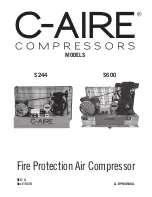
A
PPLICATION
GUIDELINES
I
NSTALLATION
Compressor connection
When brazing the compressor fittings, do not
overheat the compressor shell, which could se-
verely damage certain internal components due
to excessive heating. Use of a heat shield and/or a
heat-absorbent compound is highly recommend-
ed. For brazing the suction and discharge connec-
tions, the following procedure is advised:
• Make sure that no electrical wiring is connected
to the compressor.
• Protect the terminal box and compressor painted
surfaces from torch heat damage (see diagram).
• Use only clean refrigeration-grade copper tubing
and clean all connections.
• Purge nitrogen through the compressor in order
to prevent against oxidation and flammable con-
ditions. The compressor should not be exposed to
the open air for extended periods.
• Use of a double-tipped torch is recommended.
• Apply heat evenly to area
until the brazing
temperature is reached. Move the torch to area
and apply heat evenly until the brazing tem-
perature has been reached there as well, and then
begin adding the brazing material. Move the torch
evenly around the joint, in applying only enough
brazing material to flow the full circumference of
the joint.
• Move the torch to area
only long enough to
draw the brazing material into the joint, but not
into the compressor.
• Remove all remaining flux once the joint has
been soldered with a wire brush or a wet cloth. Re-
maining flux would cause corrosion of the tubing.
Ensure that no flux is allowed to enter into the
tubing or compressor. Flux is acidic and can cause
substantial damage to the internal parts of the
system and compressor.
The PVE oil used in MLZ compressors is highly hy-
groscopic and will rapidly absorb moisture from
the air. The compressor must therefore not be left
open to the atmosphere for a long period of time.
The compressor fitting plugs shall be removed
just before brazing the compressor.
!
Before eventual unbrazing the compressor
or any system component, the refrigerant
charge must be removed from both the high
and low pressure sides. Failure to do so may re-
sult in serious personal injury. Pressure gauges
must be used to ensure all pressures are at at-
mospheric level.
For more detailed information on the appropriate
materials required for brazing or soldering, please
contact the product manufacturer or distribu-
tor. For specific applications not covered herein,
please contact Danfoss for further information.
Moisture obstructs the proper functioning of the
compressor and the refrigeration system.
Air and moisture reduce service life and increase
condensing pressure, and cause excessively high
discharge temperatures, which can destroy the
lubricating properties of the oil. Air and moisture
also increase the risk of acid formation, giving rise
to copper platting. All these phenomena can cause
mechanical and electrical compressor failure.
For these reasons it’s important to perform a vacu-
um dehydration on the system to remove all resid-
ual moisture from the pipe-work after assembly;
MLZ and MLM compressors are delivered with
< 100 ppm moisture level. The required mois-
ture level in the circuit after vacuum dehydration
must be < 100 ppm for systems with an MLZ and
< 300 ppm for systems with an MLM compressor.
Never use the compressor to evacuate the sys-
•
tem.
Connect a vacuum pump to both the LP & HP
•
sides.
Evacuate the system to a pressure of 0.02 in Hg
•
(500 μm Hg) absolute.
Do not use a megohm meter nor apply power to
•
the compressor while it’s under vacuum as this
may cause internal damage.
Vacuum evacuation and
moisture removal
34
FRCC.PC.016.A1.22
Heat shield
C
B
A







































